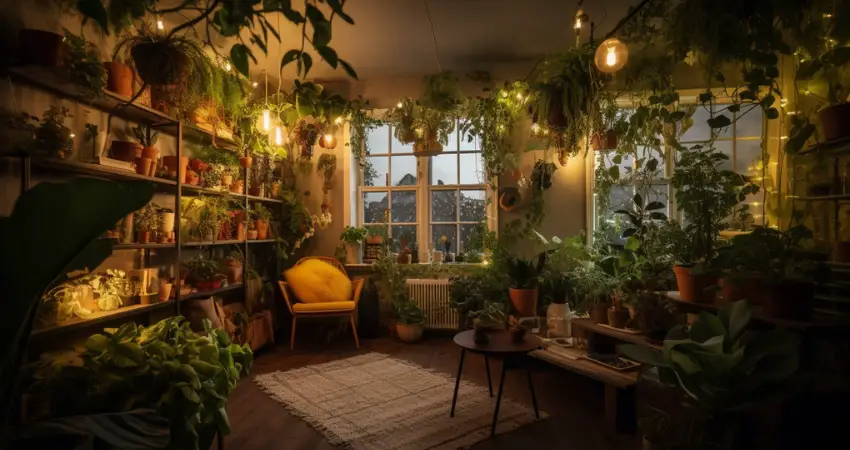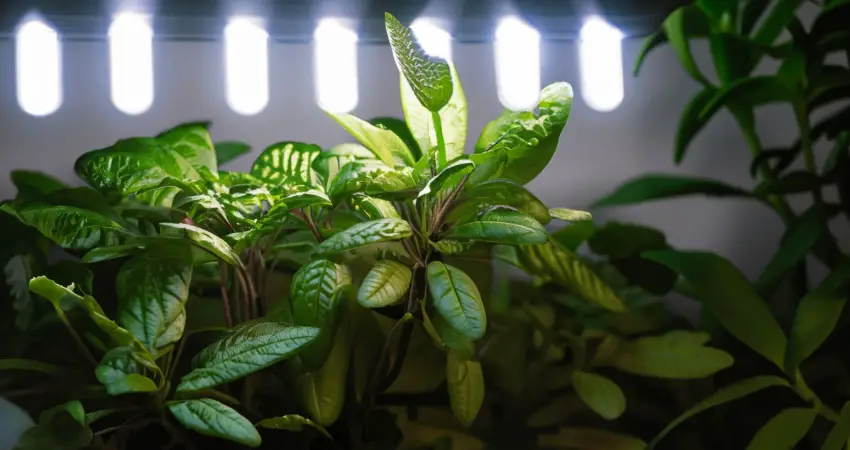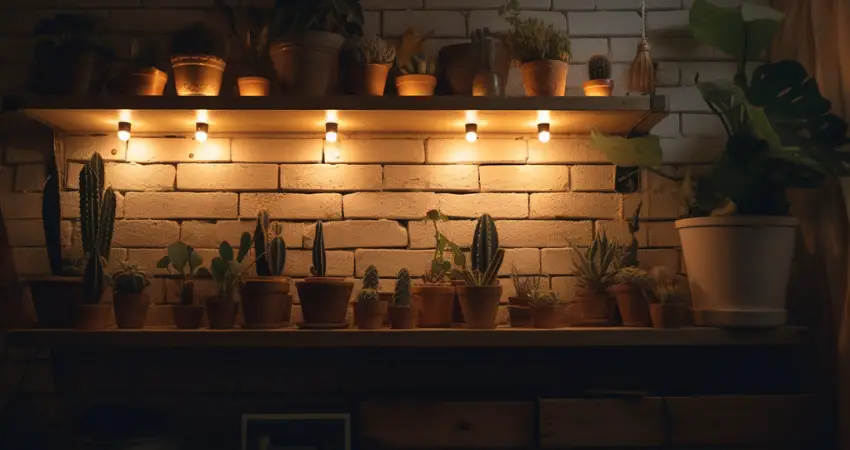Indoor gardening has seen a massive surge in popularity in recent years, and artificial lighting has played a crucial role in its growth. In this comprehensive guide, we will explore the different types of artificial lights for indoor plants, covering their advantages, disadvantages, and best use cases.
When choosing artificial lights for your indoor garden, several factors need to be considered, such as the light spectrum, light intensity, energy efficiency, cost, and lifespan. The key to successful indoor gardening lies in understanding the role of photosynthetically active radiation (PAR) in plant growth and selecting the right lighting based on your plants’ needs.
Types of artificial lights for indoor plants
In this section, we will examine the assortment of artificial lights frequently utilized for indoor plants. By grasping the distinctions, benefits, and drawbacks of each type, you will be better equipped to determine the most fitting lighting option for your unique gardening requirements. Let’s begin by investigating our first lighting category: fluorescent lights.

1. Fluorescent lights
Fluorescent lights are a popular choice for indoor gardeners due to their energy efficiency and relatively low heat output. These lights work by passing an electric current through a gas-filled tube, causing the gas to emit ultraviolet (UV) light. This UV light is then converted into visible light by the phosphorescent coating on the inside of the tube.
Types of fluorescent lights
There are three main types of fluorescent lights used in indoor gardening:
a. T5 fluorescent lights
T5 lights are high-output (HO) fluorescent lights with a diameter of 5/8 inch. They are known for their excellent light intensity and even coverage, making them ideal for small to medium-sized indoor gardens.
b. T8 fluorescent lights
T8 lights have a diameter of 1 inch and are less intense than T5 lights. They are more energy-efficient than T5s but may not provide enough light for some plant species.
c. Compact fluorescent lights (CFL)
CFLs are essentially small, twisted versions of T8 lights. They are energy-efficient and versatile, making them suitable for small indoor gardens and supplementary lighting.
Advantages and disadvantages of Fluorescent Lights
| Advantages | Disadvantages |
|---|---|
| Energy-efficient | Lower light intensity compared to some other types |
| Low heat output | Bulbs need to be replaced more frequently |
| Affordable | Limited light spectrum options |
Best use cases for indoor gardening
Fluorescent lights are well-suited for seedlings, cuttings, and plants with low to medium light requirements. They are also great for supplementing natural light in spaces with limited sunlight.
2. High-Intensity Discharge (HID) lights
High-Intensity Discharge (HID) lights are powerful, high-output lights that produce an intense light spectrum suitable for large indoor gardens. They work by creating an electric arc between two electrodes in a gas-filled chamber, producing a bright and intense light.
Types of HID lights
There are three main types of HID lights used in indoor gardening:
a. Metal Halide (MH)
MH lights produce a cool, blue-white light that is ideal for promoting vegetative growth in plants. They have a high output of PAR and are particularly effective in encouraging strong, bushy growth.
b. High-Pressure Sodium (HPS)
HPS lights emit a warm, red-orange light that is excellent for stimulating flowering and fruit production in plants. They are more energy-efficient than MH lights and have a longer lifespan.
c. Ceramic Metal Halide (CMH) or Light Emitting Ceramic (LEC)
CMH/LEC lights combine the best qualities of MH and HPS lights, producing a balanced, full-spectrum light that is suitable for both vegetative growth and flowering stages. These lights offer better color rendering, energy efficiency, and a longer lifespan compared to traditional MH and HPS lights.
Advantages and disadvantages of HID Lights
| Advantages | Disadvantages |
|---|---|
| High light intensity | High heat output |
| Wide light spectrum options | Expensive initial investment |
| Suitable for large indoor gardens | Energy consumption can be high |
Best use cases for indoor gardening
HID lights are ideal for larger indoor gardens or for plants with high light requirements, such as fruiting or flowering plants. However, they may not be suitable for small indoor gardens or heat-sensitive plants due to their high heat output.
3. Light Emitting Diodes (LED) lights
Light Emitting Diodes (LED) lights have become increasingly popular among indoor gardeners due to their energy efficiency, low heat output, and customizable light spectrum. LEDs work by passing a current through a semiconductor, which emits light in a specific color or wavelength.
Types of LED lights
There are several types of LED lights used in indoor gardening:
a. Full-spectrum LED lights
Full-spectrum LED lights mimic natural sunlight, providing a balanced light spectrum suitable for all stages of plant growth.
b. Red and blue LED lights
These LED lights primarily emit red and blue wavelengths, which are the most important wavelengths for photosynthesis. They are often used in combination for optimal plant growth.
c. White LED lights
White LED lights offer a broad spectrum of light that is suitable for general-purpose indoor gardening.
d. Quantum board LED lights
Quantum board LEDs are large, flat panels with numerous small LED chips mounted on them. These lights offer excellent light distribution and efficiency.
e. COB (Chip on Board) LED lights
COB LEDs are high-density LED chips that are mounted directly onto a substrate, creating a single, powerful light source. These lights offer high light intensity and excellent color blending.
Advantages and disadvantages of LED Lights
| Advantages | Disadvantages |
|---|---|
| Energy-efficient | Higher initial cost |
| Low heat output | Some types may not provide a full light spectrum |
| Long lifespan | Can be difficult to choose the right LED light for specific plants |
Best use cases for indoor gardening
LED lights are suitable for a wide range of indoor gardening applications, from small-scale hobby gardens to large commercial operations. They can be used for all stages of plant growth and are particularly beneficial for heat-sensitive plants.
4. Incandescent lights
Incandescent lights are the traditional light bulbs found in most households. They work by passing an electric current through a filament, causing it to heat up and emit light. Although they are inexpensive and easy to find, they are generally not recommended for indoor gardening due to their low efficiency and high heat output.
Advantages and disadvantages of Incandescent Lights
| Advantages | Disadvantages |
|---|---|
| Inexpensive | Inefficient |
| Readily available | High heat output |
| Simple to use | Limited light spectrum |
Best use cases for indoor gardening
Incandescent lights may be used as a supplementary light source for small, low-light plants or for germinating seeds. However, they are not suitable for larger indoor gardens or for plants with high light requirements.
Comparing artificial lights for indoor plants

When evaluating the various types of artificial lights for your indoor garden, it’s crucial to examine the key factors that set them apart. By comparing their light spectrums, intensities, energy efficiency, and lifespans, you can make a comprehensive decision that meets your plants’ requirements. Let’s start with a closer look at their light spectrums.
Light spectrum comparison
The color temperature (measured in Kelvin) of artificial lights has a significant impact on plant growth. Different stages of growth require different light spectrums:
- Vegetative growth typically benefits from a cooler, blue-white light with a color temperature of around 5,000-6,500K.
- Flowering and fruiting stages generally require a warmer, red-orange light with a color temperature of approximately 2,000-3,000K.
Understanding the optimal light spectrum for your plants’ growth stages is crucial for their development and overall health.
Light intensity and coverage area comparison
When comparing artificial lights, it’s essential to consider their lumens, lux, and foot-candles. These metrics help determine the light intensity and coverage area of your lighting setup:
- Lumens measure the total amount of light emitted by a light source.
- Lux measures the light intensity at a specific point and is expressed as lumens per square meter.
- Foot-candles are similar to lux but are expressed as lumens per square foot.
Different types of plants require varying levels of light intensity. Research your specific plants’ needs to ensure you provide the proper light intensity and coverage area for optimal growth.
Energy efficiency comparison
Energy efficiency is an important consideration for indoor gardeners, as it can significantly impact the overall cost of running an indoor garden. Comparing the watts per square foot of various artificial lights can help you determine the most energy-efficient option for your needs.
LED lights generally offer the highest energy efficiency, followed by fluorescent lights. HID lights tend to consume more energy, while incandescent lights are the least energy-efficient option.
Lifespan and maintenance comparison
The average lifespan of artificial lights can vary significantly:
- LED lights can last up to 50,000 hours or more.
- Fluorescent lights typically have a lifespan of around 10,000-20,000 hours.
- HID lights can last between 10,000-24,000 hours, depending on the type.
- Incandescent lights have the shortest lifespan, at approximately 1,000-2,000 hours.
Considering the lifespan and maintenance requirements of different artificial lights can help you make an informed decision when setting up your indoor garden.
Choosing the right artificial light for your indoor garden

Selecting the appropriate artificial light for your indoor garden can significantly impact its success. In order to make the best decision, it’s important to carefully evaluate your specific gardening requirements and match them with the right type of light. Let’s begin by discussing how to assess your indoor garden’s needs.
Assessing your indoor garden’s needs
Before selecting an artificial light, consider the following factors:
- Type of plants: Different plants have varying light requirements. Research your plants’ specific needs to determine the most suitable lighting option.
- Size of the growing area: The size of your indoor garden will influence the type and quantity of artificial lights needed.
- Growth stages: The growth stage of your plants will affect the optimal light spectrum and intensity required.
Matching artificial lights to your indoor garden’s requirements
Once you have assessed your indoor garden’s needs, consider the following factors when selecting artificial lights:
- Light spectrum: Choose a light that provides the appropriate color temperature and spectrum for your plants’ growth stage.
- Light intensity: Ensure the light source you select provides adequate light intensity and coverage for your growing area.
- Energy efficiency: Opt for energy-efficient lights to minimize operating costs and reduce your environmental footprint.
- Cost and budget considerations: Balance the initial cost of the lighting setup with its long-term efficiency and maintenance costs.
Tips for optimizing artificial lighting setup
To make the most of your artificial lighting setup, keep these tips in mind:
- Light placement and distance: Position lights close to your plants without causing heat stress or light burn. Adjust the distance as your plants grow.
- Light duration and scheduling: Set up a consistent lighting schedule that mimics the natural day-night cycle for your plants.
- Reflective surfaces: Use reflective surfaces or materials, such as Mylar or white paint, on the walls surrounding your growing area to increase light efficiency and distribution.
- Light layering: If possible, use a combination of light types and spectrums to create a more comprehensive lighting solution for your plants.
- Monitor and adjust: Regularly monitor your plants’ health and adjust your lighting setup as needed to ensure optimal growth conditions.
Bottom Line
Choosing the right artificial lights for your indoor plants can significantly impact their growth, health, and overall success. By understanding the different types of artificial lights available, their advantages, disadvantages, and best use cases, you can make an informed decision when setting up your indoor garden.
Whether you opt for fluorescent lights, HID lights, LED lights, or a combination of these, selecting the appropriate light spectrum, intensity, and energy efficiency for your specific plants and growing conditions will help you achieve a thriving indoor garden.
